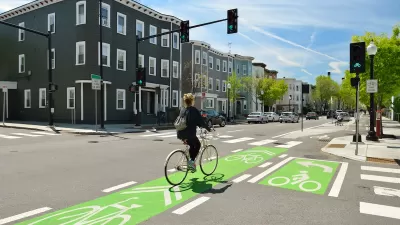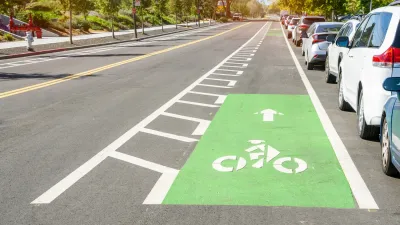The state ranks as the seventh most dangerous for pedestrians, with more than 100 pedestrian and cyclist deaths every year.

Despite being a popular destination for outdoor biking events, hosting more than 30 USA cycling events every year, writes Ty Vinson, "Arizona's cyclist and pedestrian safety measures have come into question as studies show more than 100 pedestrians and cyclists die every year in vehicle-involved crashes in metro Phoenix." To assess the extent of the issue, "[t]he Maricopa Association of Governments has been keeping track of this data through its new safety program called See Me AZ."
According to Margaret Herrera, transportation safety program manager, "fatalities have increased by 57% in the last 10 years, and the See Me AZ program is an attempt to help educate people on how to bring that number down." The Association is working with local agencies to "look for places where infrastructure could be improved to make traveling safer for all modes of transportation," and "there’s also a roadway safety program that funds short-term, immediate-need infrastructure projects."
But some cycling advocates, like Sarah Muench, editor of Clipped In, "have never heard of the See Me AZ program until now, and they were unaware of any initiatives to make the state more cyclist and pedestrian friendly." Muench "said she’d like to see more signs, ads and public service announcements about not being a distracted driver." Joey Iuliano, president of Arizona Cycling, said that "often there’s too much emphasis on the issue being everyone’s responsibility. He believes the responsibility should be on those with the most power: the drivers." Iuliano called for more sidewalks, narrower streets, protected bike lanes, and other improved infrastructure. "[I]f the state wants people to ride bikes and walk more, then it has to make them feel safe enough to do it."
FULL STORY: With Arizona cycling and pedestrian deaths rising, cyclists want more awareness from drivers

Maui's Vacation Rental Debate Turns Ugly
Verbal attacks, misinformation campaigns and fistfights plague a high-stakes debate to convert thousands of vacation rentals into long-term housing.

Planetizen Federal Action Tracker
A weekly monitor of how Trump’s orders and actions are impacting planners and planning in America.

Chicago’s Ghost Rails
Just beneath the surface of the modern city lie the remnants of its expansive early 20th-century streetcar system.

Bend, Oregon Zoning Reforms Prioritize Small-Scale Housing
The city altered its zoning code to allow multi-family housing and eliminated parking mandates citywide.

Amtrak Cutting Jobs, Funding to High-Speed Rail
The agency plans to cut 10 percent of its workforce and has confirmed it will not fund new high-speed rail projects.

LA Denies Basic Services to Unhoused Residents
The city has repeatedly failed to respond to requests for trash pickup at encampment sites, and eliminated a program that provided mobile showers and toilets.
Urban Design for Planners 1: Software Tools
This six-course series explores essential urban design concepts using open source software and equips planners with the tools they need to participate fully in the urban design process.
Planning for Universal Design
Learn the tools for implementing Universal Design in planning regulations.
planning NEXT
Appalachian Highlands Housing Partners
Mpact (founded as Rail~Volution)
City of Camden Redevelopment Agency
City of Astoria
City of Portland
City of Laramie





























